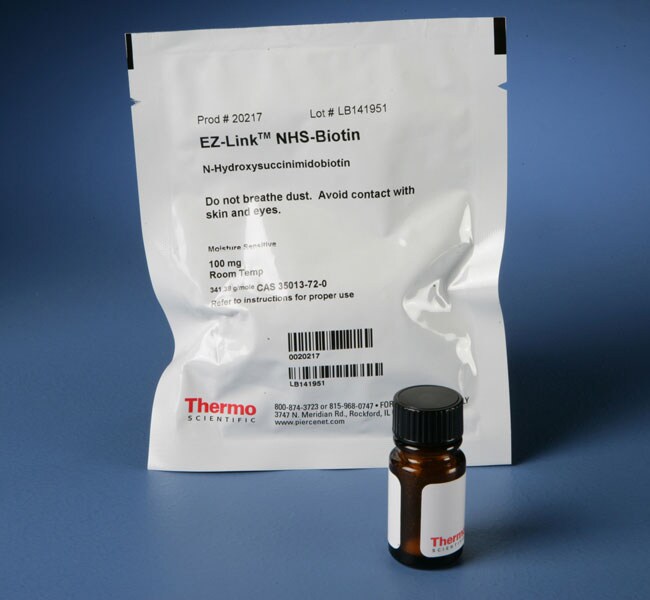
Thermo Scientific EZ-Link NHS-Biotin is the simplest NHS-ester activated biotinylation reagent for labeling primary amines (e.g., protein lysines), whose membrane permeability enables it to be used for general intracellular labeling.
Features of EZ-Link NHS-Biotin:
• Protein labeling—biotinylate antibodies or other proteins for detection or purification using streptavidin probes or resins
• Membrane-permeable—can be used to label inside cells (intracellular)
• Amine-reactive—reacts with primary amines (-NH2), such as the side-chain of lysines (K) or the amino-termini of polypeptides
• Irreversible—forms permanent amide bonds; spacer arm cannot be cleaved
• Solubility—must be dissolved in DMSO or DMF before further dilution in aqueous buffers
• Very short—spacer arm (total length added to target) is 13.5 angstroms; it consists of the native biotin valeric acid group only
NHS-Biotin is N-hydroxysuccinimidobiotin. It is the shortest of three similar EZ-Link NHS-Biotin Reagents that enable simple and efficient biotinylation of antibodies, proteins and any other primary amine-containing biomolecules in solution. Differing only in their spacer arm lengths, the three NHS-ester reagents offer researchers the possibility of optimizing labeling and detection experiments where steric hindrance of biotin binding is an important factor. Because they are uncharged and contain simple alkyl-chain spacer arms, these biotin compounds are membrane-permeable and useful for intracellular labeling.
We manufacture biotin reagents to ensure the highest possible overall product integrity, consistency and performance for the intended research applications.
N-Hydroxysulfosuccinimide (NHS) esters of biotin are the most popular type of biotinylation reagent. NHS-activated biotins react efficiently with primary amino groups (-NH2) in alkaline buffers to form stable amide bonds. Proteins (e.g., antibodies) typically have several primary amines that are available as targets for labeling, including the side chain of lysine (K) residues and the N-terminus of each polypeptide.
Varieties of biotin NHS-ester reagents differ in length, solubility, cell permeability and cleavability. Non-sulfonated NHS-biotins are cell permeable but must be dissolved in organic solvent such as DMSO or DMF. Sulfo-NHS biotins (and those with pegylated spacers) are directly water soluble but not membrane permeable. Varieties containing disulfide bonds can be cleaved using reducing agents, enabling the biotin group to be disconnected from the labeled protein.
| Code | Description |
|---|---|
| 20217 | Catalog Number: 20217 |

